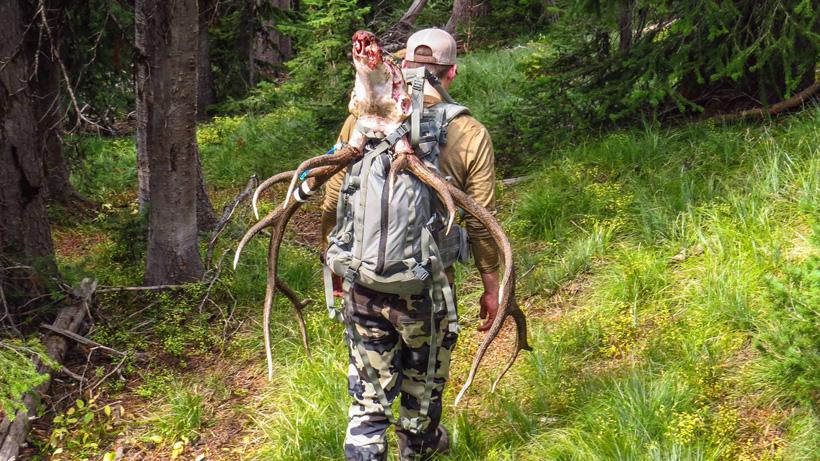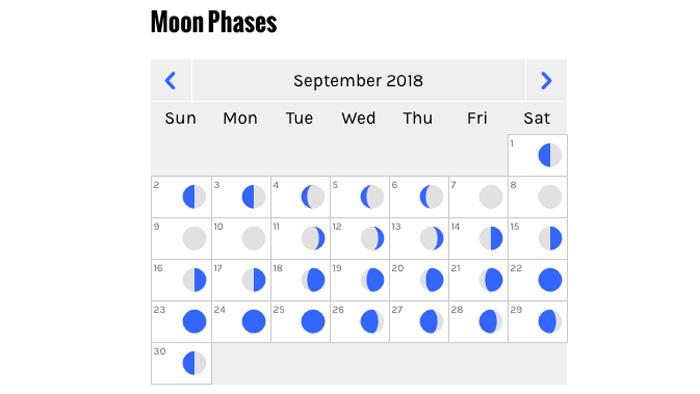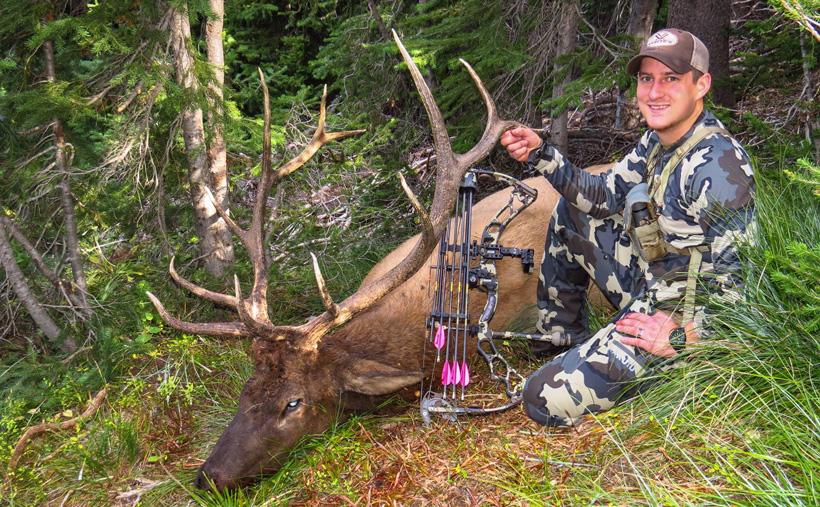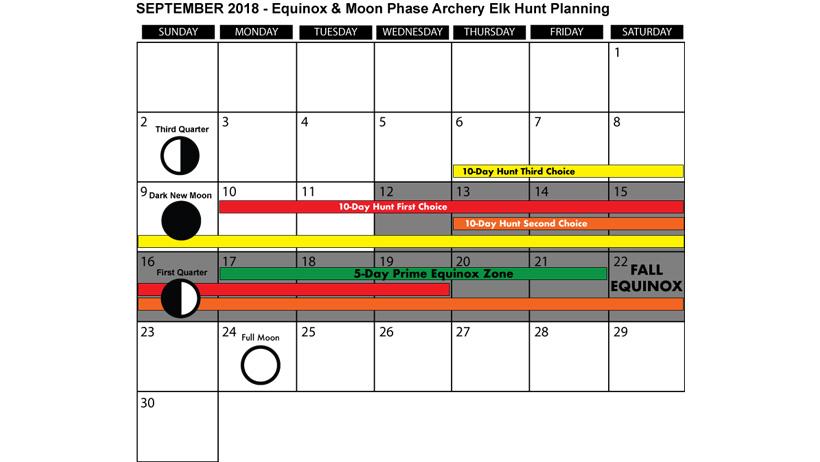




goHUNT Contributor, Dave Barnett packing out a Montana bull elk. Photo credit: Josh Volinkaty


Moon phase calendars are provided to INSIDER members inside each Unit Profile. You can start to access this data by using Filtering 2.0.

goHUNT Contributor, Dave Barnett used this strategy to take this late September Montana elk. Photo credit: Josh Volinkaty

The equinox and moon phase elk hunt planner. Source: Mark Livesay

I love packing into the backcountry with my llamas to chase elk, but I also enjoy the year-round planning, scouting, and preparations that go into elk hunting. I’ve been chasing elk for over 25 years and, each year, the excitement and anticipation never seems to dull.
Most of us are busy scratching on calendars, chatting up our wives or significant others, and arranging our work schedules to accommodate for that precious and anticipated time in the mountains. As we work through the process of obtaining elk tags, it’s important to evaluate potential hunt dates. This is especially the case when applying for—and trying to juggle—multiple species in multiple states.
The equinox and moon phases both play fundamental parts in the planning of my annual archery elk hunts.
As you read this article, keep in mind that there are always exceptions. For me, it is pretty simple. I approach bowhunting for elk as an odds game. My goal is to stack as many odds in my favor as possible. Odds, not only as they relate to the state, harvest and unit statistics, but also the odds of how bull elk might respond to the calling tactics I use during the rut and archery season. I feel if you place yourself among the elk at the right time, you dramatically increase your odds of success.
Elk equinox and moon phase
I live in the big sky and big bull state of Montana. This fact equates to a very liberal and long archery season. I’m also incredibly blessed to now have both the time to spend and an understanding wife. This extraordinary combination allows me to chase rutting bulls with my bow in multiple states during the entire month of September and several weeks into October.
This was not always the case. Before we moved west to Montana, like most elk hunters, I had a finite number of days I could spend in the mountains. Planning my hunts around the equinox and moon phases allowed me to maximize those precious days and increase the odds.
Most experts today agree that cow elk enter their first estrus cycle right around the fall equinox. Thus, the peak of the breeding cycle usually falls within five to 10 days of the fall equinox. In 2018, the fall equinox is on Sept. 22. If you want to get specific, it is at 7:54 p.m. MST. This is a special day in the world of archery elk hunting. Only on that day does the sun rise due east and set exactly due west. The great news about the equinox is that it does not change much from year to year. You can count on it falling on either Sept. 21 or 22 for most of your hunting life.
With that date in mind, the best time to insert yourself among the elk is heavily weighted towards the 10 days leading up to the fall equinox—not on the equinox itself. This certainly does not mean there is not good rutting, bugling or even hunting before or after those days. It simply means this is the timeframe when bulls are generally the most vulnerable. Remember that we are playing the odds game!
GOHUNT Contributor, Dave Barnett packing out a Montana bull elk. Photo credit: Josh Volinkaty
Very early in September, possibly even August in some areas, bulls begin to advertise and locate other bulls to establish their dominance. They sense the rut is coming and they are sounding off to let other bulls and cows know they are in the area. In the early days of September, bulls may respond to calls and be quite interested; however, at this time, many you often need to be pretty darn close to get a real strong reaction out of them.
We had this exact scenario happen on the opening day in Montana. My hunting partner and I hiked several miles and tried locating bugles for most of the day. No response! I know those bulls could hear us bugling, long before we got close, but they remained silent. Late that afternoon, we finally stumbled a little too close for comfort and the game was on. Within just a few minutes, we had multiple bulls bugling and two shot opportunities. Two bulls responded and approached quickly with reckless abandon, but we heard nothing from those bulls until we were right on top of them!
In those early rut days, the bulls seem to be interested in who is in the area, but less keen—even resistant—to responding or coming in from longer distances. The other problem during the early days is that younger, less mature bulls often come in silent, making them harder to anticipate.
As elk enter those magic 10 days preceding the equinox, the bulls begin to find and smell more cows entering estrus. It does not take many cows coming into estrus to get the whole area on fire. Elk act plain dopey when there are receptive cows around. This is the perfect time to take advantage of that weakness. As the equinox approaches, the bulls are also becoming more aggressive and anxious. They are working hard to show dominance and draw cows to them, but are just beginning to establish and build harems.
During this time, bulls announce and proclaim their presence to attract more and more cows. Cows are looking to hook up with bulls with the biggest antlers and, perhaps, the most enticing bugles. As more cows continue to enter estrus, mature bulls will take more chances in an attempt to gather more cows. This can make them more susceptible to calling tactics—both cow calls and challenge bugles. Five days out from the equinox is a great day to be among the elk.
During the 10 days preceding the equinox, hunting pressure and hunter calling is certainly escalating. Even so, I’m still able to find more bulls that are willing to respond. Bulls can quickly become call and encounter “educated” later in the season. This is especially true after the equinox. If you are able to hunt more remote areas, you may find more bulls willing to play the game for longer periods of time because they have not been exposed to as many hunters. If you hunt less remote and more pressured areas, it may be more advantageous to hunt the earlier part of the 10-day period.
The closer you get to the actual equinox and the days following, the more established the elk herds and harems become. This is when herd bulls become much more difficult to entice. They are still interested in breeding and can be quite vocal, but they can many times be much harder to persuade with calls. At this point in the season, they have faced hunter contact, all sorts of crazy calling, weather conditions and, certainly, each other. Once a herd bull has established his harem, they are far less likely to leave their cows for a distant challenging bugle or even a cow call. It’s the bird-in-hand scenario.
Sure, you might see and hear a lot of bugling, but getting an actual shot with stick and string might prove to be arduous. It can be a fun and exciting time, but it can also be quite frustrating. When herd bulls become more onerous so do your odds. It's simple encounter math. Again, there are exceptions to every rule and those times make for amazing stories. In the end, however, success in elk hunting is a game of odds. The best elk hunters do everything they can to increase their odds.
In most areas, the majority of cows become pregnant during the first estrus cycle. Cows are only receptive to breeding for about 24 hours. In cases where cows don’t get bred during their first cycle, there is a second, third and, even, a fourth estrus cycle. Typically, a cow that has not been bred will return to a second estrus cycle in about 20 days. There can be some rutting activity during the other cycles, but we are back again to evaluating the odds game. There certainly won’t be as much.
Now we put the moon phase into the equation (take a look at the graphic above for a refresher). How does it apply to our hunt planning? Unlike some people, I don’t believe the moon phase changes the actual dates of the elk rut. I’m convinced that when cows come into estrus, it is game on, no matter what the moon is doing. The equinox is the key factor in determining the estrus cycle. The moon has little, if anything, to do with it.
However, you can’t ignore the moon phase. It may not change the estrus cycle, but it can dramatically affect your hunting success and especially your tactics.
Moon phase calendars are provided to INSIDER members inside each Unit Profile. You can start to access this data by using Filtering.
Hunting elk during a full moon can be especially challenging. Even so, I believe you must balance those special days running up to the equinox with the corresponding moon phases. A slight adjustment of only a few days can make a huge difference in your encounters and opportunities for a shot.
The more full the moon, the more likely the bulls will be active and rutting at night versus the day. This does not mean they can’t and won’t be active during the daylight hours. A lot can depend on rut timing, the number of cows in estrus, hunting pressure and weather, but you may have to adjust your tactics and timing.
I’ve found that during a full moon and the days immediately following it, the hunting can be good during the mid-day. The bulls have been in their beds since early that morning and seem to get restless about mid-day. Many times they will sound off or even respond to a bugle in the middle of the day. Too many hunters miss those times because they did not adjust to the elk’s patterns and are, consequently, not in a position to experience it.
Very early mornings during a full moon can also be good. If you can get out very early, locate bulls with bugling during the night and then place yourself in a very close position at first light you can often get to them before they bed down. You may not have much time, however, as elk tend to retreat to bed more quickly on full moon mornings. So be ready.
Another moon pattern I have noticed is that elk tend to be more active during daylight hours on the days leading up to a full moon as compared to the days following the full moon. It seems once they get used to running at night during the full moon, it takes them a bit to get out of that pattern. Before the full moon, they are still used to moving during the day.
Elk hunting is never a sure thing no matter what you do. You just never know and you can’t predict when success it’s going to happen. But one thing I do know is that you can stack the odds in your favor.
GOHUNT Contributor, Dave Barnett used this strategy to take this late September Montana elk. Photo credit: Josh Volinkaty
The average hunter can typically spend seven to 10 days chasing elk with a bow. If I had limited time to hunt elk in 2018, my first choice would be Sept. 10 to 19. The moon is new and dark on the 9. As the dark moon builds towards the full moon on Sept. 24 and the equinox occurring on Sept. 22, so will the rutting cycle. This date range includes several low moon nights and three of the five days preceding the equinox. These factors could be a great combination. I plan on being packed in somewhere hunting elk most days in September, but I absolutely will focus my hunts around those special days.
The equinox and moon phase elk hunt planner. Source: Mark Livesay
Unfortunately, that date range may not fall on the best dates for work scheduling and maximizing weekends. If that’s the case, starting the hunt on the weekend of Sept. 13 would be my second choice. Yes, the moon is stronger and still building towards full, but this range includes all five days before the equinox.
My third choice would be the weekend of Sept. 6. During this range, you will need to keep in mind that it is still the early stages of the rut cycle and the bulls might not be quite as aggressive. They will still respond, but many may come in silent. The good news is that the moon will be dark for most of this hunt and the elk will be more active during the day.
Remember: any day hunting elk is better than not!
For a great article on how to break down a week of elk hunting, you can check out this great article by Randy Newberg here.